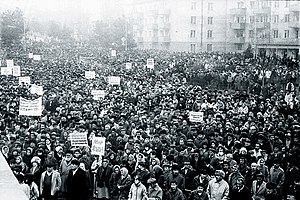| Karabakh movement | |||
|---|---|---|---|
| Part of the Nagorno-Karabakh conflict, First Nagorno-Karabakh War and the dissolution of the Soviet Union | |||
 The first major demonstration in Stepanakert, February 13, 1988 | |||
| Date | 13 February 1988 — 30 April 1991 | ||
| Location | |||
| Goals | Unification of Nagorno-Karabakh with Armenia | ||
| Methods | Demonstrations, sit-ins, strikes, hunger strike, student protest, civil disobedience | ||
| Resulted in | Establishment of the Nagorno-Karabakh Republic Escalation of the First Nagorno-Karabakh War | ||
| Parties | |||
| Lead figures | |||
| Number | |||

The Karabakh movement (Armenian: Ղարաբաղյան շարժում), also known as the Artsakh movement[7][8] (Armenian: Արցախյան շարժում), was a national mass movement[9] in Armenia and Nagorno-Karabakh from 1988 to 1991 that advocated for the transfer of the mainly Armenian-populated Nagorno-Karabakh Autonomous Oblast of neighboring Azerbaijan to the jurisdiction of Armenia.
Initially, the movement was entirely devoid of any anti-Soviet sentiment and did not call for independence of Armenia. The Karabakh Committee, a group of intellectuals, led the movement from 1988 to 1989. It transformed into the Pan-Armenian National Movement (HHSh) by 1989 and won majority in the 1990 parliamentary election. In 1991, both Armenia and Nagorno-Karabakh declared independence from the Soviet Union. The intense fighting known as the first Nagorno-Karabakh War turned into a full-scale war by 1992.[citation needed]
- ^ Flag of Armenia was adopted on August 24, 1990.
- ^ "Soviet Armenia erupts in protests". The Daily News. 24 February 1988. Archived from the original on 11 August 2022. Retrieved 16 July 2013.
- ^ a b c d Armenians protest USSR’s refusal to honor Nagomo-Karabakh annexation referendum, 1988 Archived 2022-09-17 at the Wayback Machine Matthew Heck, Global Nonviolent Action Database, December 5, 2010
- ^ "Pravda Talks of Ethnic Woes". New York Times. 19 April 1988. Archived from the original on 11 August 2022. Retrieved 16 July 2013.
As many as one million people demonstrated in the Armenian capital of Yerevan in February to demand that Nagorno-Karabakh be made part of Armenia
- ^ "Mass Protests Said to Flare In Soviet Armenian Capital". New York Times. 31 May 1988. Archived from the original on 30 May 2023. Retrieved 16 July 2013.
- ^ "The Press-Courier - Google News Archive Search". news.google.com. Archived from the original on 2022-12-19. Retrieved 2020-09-27.
- ^ "An event dedicated to the 25th anniversary of the Artsakh Movement taken place at the US Congress". Ministry of Foreign Affairs Nagorno-Karabakh Republic. 13 February 2012. Archived from the original on 20 March 2023. Retrieved 4 August 2013.
- ^ "The Artsakh Movement started on this day 25 years ago". Public Radio of Armenia. 20 February 2013. Archived from the original on 17 August 2016. Retrieved 4 August 2013.
- ^ Panossian, Razmik (2006). The Armenians: From Kings and Priests to Merchants and Commissars. New York: Columbia University Press. p. 385. ISBN 9780231139267.
The Gharabagh movement in Armenia—as mobilised for and through the issue of the enclave's unification to the republic—is a prime example of a mass national movement.